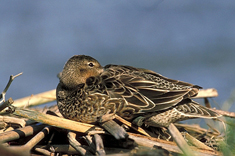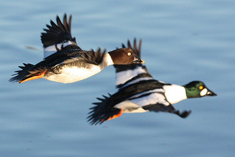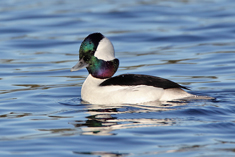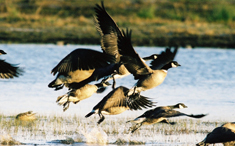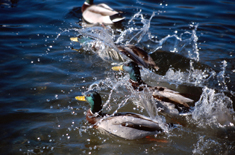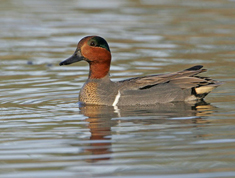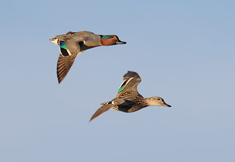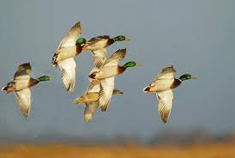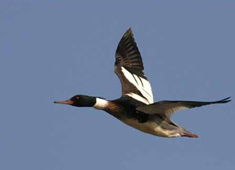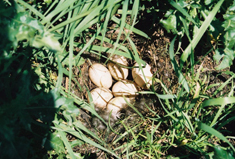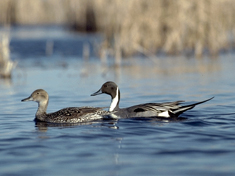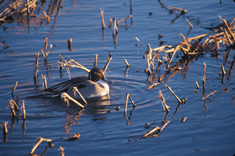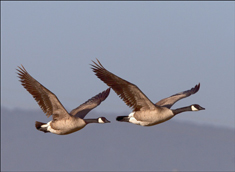
The oldest known goose to be taken by a hunter was a Canada goose that was estimated to be 29 years old.
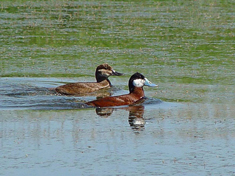
Ruddy ducks produce the largest eggs relative to their body size of any duck. A clutch of ruddy duck eggs can weigh more than the hen that laid them.
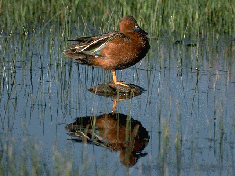
The only North American dabbler or diver that also breeds in South America is the cinnamon teal.
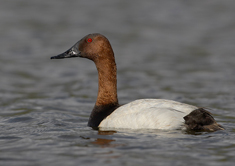
The oldest known duck to be taken by a hunter was a canvasback harvested at the ripe old age of 29.
The female Cinnamon Teal often places her nest below matted, dead stems of vegetation so it is completely concealed on all sides and from above. She approaches the nest through tunnels in the vegetation.
Both common and Barrow’s goldeneyes are often called whistlers. On cold, windless days, the resonant whistling sound produced by goldeneyes’ rapidly beating wings can be heard a half-mile away.
Buffleheads are often called “butterballs” by waterfowlers for good reason. These birds can store upwards of four ounces of fat—more than a quarter of their body weight—in preparation for fall migration.
Waterfowl wings provide the two essential elements of flight. Primary feathers (those on the tips of the wings) provide thrust, while secondary feathers (those on the rear edge of the wings) provide lift.
Genetic analysis of mallard broods has shown that many clutches include eggs that were fertilized by different drakes. The hens may actually seek multiple mates to ensure their clutches will be successfully fertilized. This behavior also produces greater genetic variation among broods.
With eyes located on either side of their head, waterfowl have a field of vision of almost 340 degrees, enabling them to see just about everything above, below, in front of, and behind them at the same time. The saucer-shaped eyes of waterfowl also allow them to see both close and distant objects in sharp focus simultaneously.
Blue-winged and green-winged teal, thought by many hunters to be the fastest ducks, are actually among the slowest, having a typical flight speed of only 30 mph.
Most waterfowl fly at speeds of 40 to 60 mph, with many species averaging roughly 50 mph. With a 50 mph tail wind, migrating mallards are capable of traveling 800 miles during an eight-hour flight. Studies of duck energetics have shown that a mallard would have to feed and rest for three to seven days to replenish the energy expended during this eight-hour journey.
The fastest duck ever recorded was a red-breasted merganser that attained a top airspeed of 100 mph while being pursued by an airplane. This eclipsed the previous speed record held by a canvasback clocked at 72 mph.
Hen mallards molt during late fall or winter. The birds replace their “basic” plumage acquired during the summer molt with darker brown “alternate” plumage. These darker, more clearly defined feathers help camouflage the birds while nesting in the spring.
Ducks usually migrate at an altitude of 200 to 4,000 feet but are capable of reaching much greater heights. A jet plane over Nevada struck a mallard at an altitude of 21,000 feet—the highest documented flight by North American waterfowl. And a 1954 climbing expedition to Mount Everest found a pintail skeleton at an elevation of 16,400 feet.
A pintail banded in 1940 in Athabasca, Alberta, survived until January 1954 when it was shot near Naucuspana, Mexico, roughly 3,000 miles away. If this pintail migrated between these two locations every year throughout its known lifetime, the bird would have logged nearly 80,000 air miles.

